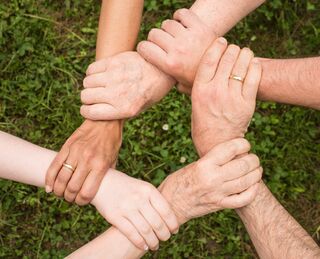Coronavirus Disease 2019
The Psychological Impact of Testing Positive for COVID-19
This week I tested positive for COVID. What do you need to know?
Posted August 31, 2020 Reviewed by Kaja Perina

There’s just no way to navigate this pandemic perfectly. Even if, like me, you're a mask-wearer, social-distancer, and hand-washer, mistakes will be made. Infections will occur.
Case in point: despite great caution and care, this week I tested positive for COVID-19.
I was sure it was an error. I asked the nurse to check, then check again. I have no symptoms; I got tested because it’s the responsible thing to do after flying. I wore a fitted N95 mask the entire flight, removing it only to drink water. I've been incredibly careful since the pandemic began. How did this happen?
The psychological impact of testing positive for Coronavirus is like having a speeding train slam squarely into your chest. It isn't a death sentence, but - given all the horrifying things we've read and seen - it feels like one. On top of that, I feel like a walking vector: monstrous, infectious, dangerous. Also, terrified. It's maddening dealing with all of the unknowns. Am I in danger? If so, how much? When did I get infected, and how? Did I have COVID before I flew? I’m a healthcare provider who’s devoted her entire life to helping and healing others. Have I inadvertently given COVID to others...?
The worst phone calls I’ve ever had to make, I made this week. Upon receiving my positive diagnosis, I contacted everyone I’d recently seen – including the beloved friend who’d invited me cross-country, the very friend who’d offered shelter from the suffocating smoke filling my home. When the California wildfires threatened to evacuate surrounding neighborhoods, and my smoke alarm rang with warning, she offered refuge. I hadn't even considered flying since the pandemic began, but the "worth it" scales had tipped. After researching the CDC’s and Mayo Clinic’s latest recommendations for flying during COVID, and consulting with physician colleagues about the risks, I left home in search of clean air and safety.
Upon arriving, I planned to quarantine in an isolated cabin, get tested, then stay with her after testing negative. The first available testing appointment was two days away. We were so excited to see each other that we scheduled a socially-distant backyard picnic. With her children, six feet apart. It involved eating dinner outdoors. Unmasked.
When I got the call from the nurse with the nervous, trembly voice, all I could think about was that picnic. It forced itself into my mind’s eye in sharp focus, all details comically exaggerated. The blue sky with the absurdly puffy white clouds. My friend’s beautiful 8-year-old daughter, family to me, offering me a sweet summer cherry from her cup. Did I usher her away in time...? Was the picnic worth it?
The era of COVID: every day, a new “Worth It” scale. Every decision, even the most basic, one that might risk your life and the lives of the people you love. For the foreseeable future, this is our reality. It's a reality we all need to prepare for: normal human mistakes, positive test results, nerve-wracking phone calls, living with fear that feels beyond our capacity to bear.
They’ve scheduled their tests for next week, factoring in the requisite 5-7 day "incubation period;" then it will be another few days before we find out the results. The anxious anticipation is intense.
You should prepare for it, too.
It’s now been five days since I left California. I continue to have no symptoms. I wake up every morning wondering if this is the day that Coronavirus will lay siege to my body, stealing my lungs and life. I calm myself with evidence: the vast, vast majority of people who contract COVID survive and are fine. Furthermore, according to the CDC, 40% of COVID patients are completely asymptomatic, and, according to the World Health Organization, therefore much less contagious - though this is still being debated. Furthermore, although unlikely, my test may be a false positive. According to Harvard Health, false positives - while uncommon - can occur up to 5% of the time. (Note that false negatives, indicating that you don’t have COVID when you actually do, are much more common and concerning, occurring at a rate of 2-37%.) And perhaps the most important and likely alternative: I may indeed have COVID but continue to feel well despite infection.
Before testing positive, I told a friend that we all needed to hear more stories of people surviving and even living well with C19 - stories of the asymptomatic, the mildly symptomatic - and I hope to be one of those. The vast majority of C19 cases aren't lethal, and that’s important for us to know if we’re going to effectively manage our anxiety and stress. There’s now also another possibility: according to yesterday’s New York Times, I may have a minimal, noncontagious amount of C19 in my system. That is: current tests don’t accurately indicate how much virus you have in your body, whether or not you’re infectious, or how infectious you are.
Despite many unknowns, we do know that anyone who tests positive should immediately quarantine in order to protect others from infection - loved ones and strangers alike. And while we need more accurate tests ASAP, I’m enormously grateful that there are any tests at all, and that they are readily available. Thanks to science, I know I likely have COVID when I would've otherwise been unaware. For the next 2 weeks, I will isolate in my cabin in the woods, door open, with full view of lake and sky. I feel lucky to be healthy today, lucky to breathe in and out, lucky to have friends and family checking on me.
It’s time to step up our game. Going forward, before making any decisions, I want you to imagine having to tell the people you love most that you may have infected them. Protect your family and your community by protecting yourself: wear a mask, avoid big groups, keep your distance, wash your hands. Don’t assume you don’t have COVID just because you have no symptoms. That feeling you have that the person walking by just might have C19...? THAT'S TRUE. Show up in spades for anyone you know who tested positive, offering love and support. Find ways to safely be in community, either online or at a distance: social isolation leads to depression, anxiety and immunosuppression. Take care of your stress and anxiety by following these tips. Any opportunity you have to be kind to someone, take it. These are weird and wild times, and people are suffering. Please share this article with anyone you think might benefit. Stay safe and be well.
References
Shmerling, R. Harvard Health: Which Test is Best for Covid-19? Aug 10, 2020.
CDC. Travel During the Covid-19 Pandemic. Aug. 26, 2020.
Mayo Clinic. Coronavirus Travel Advice. Aug 8, 2020 https://www.mayoclinic.org/coronavirus-safe-travel-advice/art-20486965
CDC. COVID-19 Pandemic Planning Scenarios. https://www.cdc.gov/coronavirus/2019-ncov/hcp/planning-scenarios.html
Mandavilli, A. Your Coronavirus Test Is Positive. Maybe It Shouldn’t Be. Aug 29, 2020. https://www.nytimes.com/2020/08/29/health/coronavirus-testing.html
World Health Organization (WHO). Transmission of COVID-19 by asymptomatic cases.




